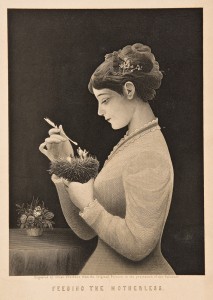This is an excerpt from “The Sunlight Falls Across My Bed,” a chapter of the New Woman Olive Schreiner’s 1898 book, Dreams, which she wrote in South Africa, where she spent much of her life. The chapter follows a narrator’s journey through hell and heaven for which God is her tour guide. It defies expectations of Victorian literature through its manipulation of and deviation from Victorian strategies of addressing sexuality. Schreiner begins with hallmark elements of Victorian art and literature. For example, the narrator compares women to fruit and uses sensuous imagery that creates a vision of gluttonous pleasure in corporeal satisfaction. She says, “they were tall and graceful and had yellow hair… over their heads hung yellow fruit like large pears of melted gold” (Schreiner 134). The reader expects that this work will remain within the confines of Victorian depictions of sexuality in veiled terms and will paint women as passive actors and objects of pleasure. This impression is quickly shattered in the paragraphs that follow. In this way, this piece of writing defies the Victorian expectations of sexuality depictions and acceptable gender roles.
The first break from expectation is the women’s active role. Instead of tasting the fruit and being confined to hell, the women the narrator sees simply prick the fruits that they, “are poisoning” before the men eat them (Schreiner 135). Setting aside the connotations of that action, women in this scene are deciding the fates of men, something that does not happen in the sexual dynamics of typical Victorian works. Though the women possess some of the ideal traits of this era, being “tall and graceful” and “delicate,” they use these qualities for nefarious purposes (Schreiner 134). I argue this is a step past the seductive women portrayed by so many of the Pre-Raphaelites and other aesthetes, who were a danger to men, yet not through their own agency and confined to the role of passive object.
The next break from the monolithic Victorian is in the subject matter of this excerpt. Though it is coded, there is a metaphor which explains the spread of venereal diseases through the illegal sex trade. Schreiner highlights the covert nature of such interactions by repeatedly reinforcing the women’s attention to secrecy. Before piercing the fruits, each woman, “looked this way and that,” and only attempt their mission when they “saw no one there” (Schreiner 135). God explains to the narrator that the women “touch it with their lips, when they have made a tiny wound in it with their teeth they set in it that which is under their tongues: they close it with their lip—that no man may see the place, and pass on” (Schreiner 135). This depiction is much more explicit than most addresses of sexuality, prostitution, and disease seen in the Victorian canon.
This passage deviates from accepted discourse on sexuality by addressing specific aspects of venereal disease. By stating that the men do not and cannot know which fruits are tainted, Schreiner describes how symptoms present differently (or not at all) in women versus men. The fact that the author knew about such particulars would be shocking in itself, but placing them in a narrative and putting them in conversation with religion by choosing to have God explain them falls far outside the perceived Victorian norm.
More subtly, but I think more meaningfully, Schreiner addresses the emotional bankruptcy of both parties after a sexual transaction. Instead of focusing on the moral deprivation of participants in the sex trade, which would be permissible as a didactic woman’s writing informed by faith, Schreiner points out that both women and men are losers at the end of such transactions when God says they gain, “Nothing” (Schreiner 136). Going even further, she asserts that their carelessness is from fear, which eliminates other concerns. This is a claim by Schreiner that Victorian suppression of sexuality is the root cause of its most chastised behaviors and a much more pervasive threat to people’s well-being, and such a challenge is the most radically “queer” aspect of this selection.
My VQA Entry Image from HATHI TRUST
Image from HATHI TRUST
 Image from Wikipedia (
Image from Wikipedia (
